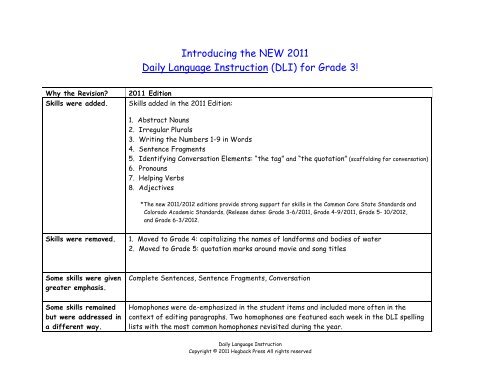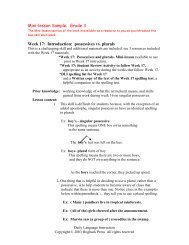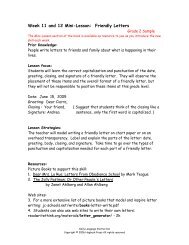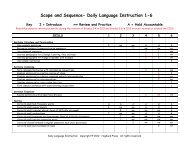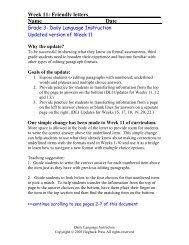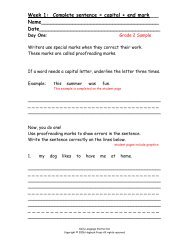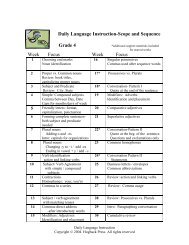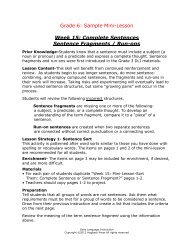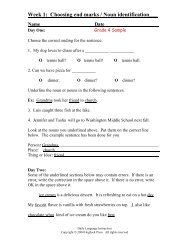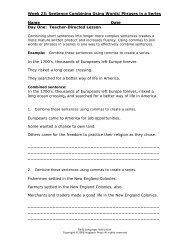Introducing the NEW 2011 Grade 3 Edition
Introducing the NEW 2011 Grade 3 Edition
Introducing the NEW 2011 Grade 3 Edition
You also want an ePaper? Increase the reach of your titles
YUMPU automatically turns print PDFs into web optimized ePapers that Google loves.
<strong>Introducing</strong> <strong>the</strong> <strong>NEW</strong> <strong>2011</strong><br />
Daily Language Instruction (DLI) for <strong>Grade</strong> 3!<br />
Why <strong>the</strong> Revision?<br />
Skills were added.<br />
<strong>2011</strong> <strong>Edition</strong><br />
Skills added in <strong>the</strong> <strong>2011</strong> <strong>Edition</strong>:<br />
1. Abstract Nouns<br />
2. Irregular Plurals<br />
3. Writing <strong>the</strong> Numbers 1-9 in Words<br />
4. Sentence Fragments<br />
5. Identifying Conversation Elements: “<strong>the</strong> tag” and “<strong>the</strong> quotation” (scaffolding for conversation)<br />
6. Pronouns<br />
7. Helping Verbs<br />
8. Adjectives<br />
*The new <strong>2011</strong>/2012 editions provide strong support for skills in <strong>the</strong> Common Core State Standards and<br />
Colorado Academic Standards. (Release dates: <strong>Grade</strong> 3-6/<strong>2011</strong>, <strong>Grade</strong> 4-9/<strong>2011</strong>, <strong>Grade</strong> 5- 10/2012,<br />
and <strong>Grade</strong> 6-3/2012.<br />
Skills were removed.<br />
1. Moved to <strong>Grade</strong> 4: capitalizing <strong>the</strong> names of landforms and bodies of water<br />
2. Moved to <strong>Grade</strong> 5: quotation marks around movie and song titles<br />
Some skills were given<br />
greater emphasis.<br />
Complete Sentences, Sentence Fragments, Conversation<br />
Some skills remained<br />
but were addressed in<br />
a different way.<br />
Homophones were de-emphasized in <strong>the</strong> student items and included more often in <strong>the</strong><br />
context of editing paragraphs. Two homophones are featured each week in <strong>the</strong> DLI spelling<br />
lists with <strong>the</strong> most common homophones revisited during <strong>the</strong> year.<br />
Daily Language Instruction<br />
Copyright © <strong>2011</strong> Hogback Press All rights reserved
Some effective<br />
teaching strategies<br />
were used in some but<br />
not all grade levels of<br />
DLI.<br />
1. Added a week of instruction to introduce Conversation Elements. Prior to <strong>the</strong> <strong>Grade</strong> 3<br />
revision, <strong>the</strong>se concepts were included only in <strong>the</strong> <strong>Grade</strong> 2 and <strong>Grade</strong> 6 editions, which were<br />
developed at a later time.<br />
Implication: Include<br />
<strong>the</strong>se strategies in<br />
<strong>the</strong> new editions<br />
(3-4-5-6) to create<br />
a “seamless flow”<br />
from one grade level<br />
to <strong>the</strong> next.<br />
2. Added <strong>the</strong> “House Model” strategy, which debuted in <strong>the</strong> <strong>Grade</strong> 6 edition, to <strong>Grade</strong>s 3-4-<br />
5. The “House Model” compares a complete sentence (independent clause) to a house. The<br />
subject and predicate each contribute one-half of <strong>the</strong> complete house. This makes an<br />
abstract concept more concrete to students and helps develop <strong>the</strong> idea of a complete<br />
sentence. This model is useful to support <strong>the</strong> concept of a compound sentence in<br />
<strong>Grade</strong> 4; it is represented by a duplex house.<br />
The weekly minilesson<br />
is critical to<br />
provide <strong>the</strong> direct<br />
instruction on <strong>the</strong><br />
focus skill.<br />
For that reason, <strong>the</strong><br />
mini-lesson section<br />
was streng<strong>the</strong>ned to<br />
better support<br />
teachers in planning<br />
and carrying out this<br />
foundational weekly<br />
lesson.<br />
The Mini-Lesson Section grew from 19 pages in <strong>the</strong> 2003 edition to 68 pages in length.<br />
This part of <strong>the</strong> DLI resource is an invaluable support to teachers whe<strong>the</strong>r <strong>the</strong>y are<br />
veterans or new to <strong>the</strong> grade level.<br />
Teaching strategies include songs and many interactive activities to encourage active<br />
participation. Picture books and related websites are offered and several strategies are<br />
provided to introduce each skill.<br />
The new edition offers more background information on <strong>the</strong> focus skills for teachers, which<br />
can be important with <strong>the</strong> increased rigor in <strong>the</strong> standards and <strong>the</strong> number of new skills<br />
that have been added.<br />
Daily Language Instruction<br />
Copyright © <strong>2011</strong> Hogback Press All rights reserved
Pre-post assessments<br />
have been added at<br />
six-week intervals.<br />
Text boxes are used<br />
to draw students’<br />
attention to short,<br />
embedded minilessons.<br />
Pre-post assessments are valuable tools to support your instruction. While a spiraling review<br />
is built into <strong>the</strong> DLI materials, <strong>the</strong> pre-post assessments will easily allow you to identify<br />
areas where more support may be needed and to celebrate growth with your students.<br />
Text Boxes to Introduce New Concepts<br />
Text boxes are used in <strong>the</strong> new edition to support <strong>the</strong> introduction of a new concept and to<br />
focus students’ attention on key ideas. The information in <strong>the</strong> text box effectively<br />
presents <strong>the</strong> new concept with definitions and examples.<br />
This is ano<strong>the</strong>r way that <strong>the</strong> new edition supports <strong>the</strong> direct instruction on <strong>the</strong> focus skill.<br />
The new edition<br />
supports a smooth<br />
transition for<br />
students from <strong>the</strong><br />
<strong>Grade</strong> 2 DLI<br />
materials to <strong>Grade</strong> 3.<br />
The <strong>Grade</strong> 2 edition features one sentence each day for students to correct. Manuscript<br />
dotted lines are provided to record answers. These sentences offer practice opportunities<br />
for new and review skills. This same type of sentence has been added to <strong>the</strong> <strong>Grade</strong> 3<br />
edition for <strong>the</strong> first six weeks; <strong>the</strong> use of this transitional sentence diminishes each week.<br />
Additional formats<br />
have been added to<br />
prepare students for<br />
formal assessments<br />
more effectively.<br />
A greater variety of formats is employed in <strong>the</strong> <strong>2011</strong> edition. Since DLI is used in many<br />
states, a broad range of formal assessment formats supports test preparation.<br />
In addition, we responded to a concern expressed by teachers who shared that students<br />
had experienced difficulty in navigating changes in state assessment editing paragraph<br />
formats. These formats required students to transfer thoughts about items on a page on<br />
<strong>the</strong>ir left to a page on <strong>the</strong>ir right where answers were recorded.<br />
Practice with transferring thoughts from <strong>the</strong> top to <strong>the</strong> bottom of <strong>the</strong> page was added<br />
early in <strong>the</strong> year, and practice transferring from left to right was added by mid-year.<br />
Daily Language Instruction<br />
Copyright © <strong>2011</strong> Hogback Press All rights reserved
Format changes have<br />
enhanced <strong>the</strong> new<br />
edition.<br />
1. Comic Sans font replaced Times New Roman. The letter formations in Comic Sans are<br />
similar to <strong>the</strong> formations that students use in <strong>the</strong>ir manuscript writing, and it has a clean,<br />
un-cluttered look.<br />
2. Effective graphics were added to support <strong>the</strong> introduction of big ideas: conversation<br />
and possessives vs. plurals.<br />
3. The header at <strong>the</strong> top of <strong>the</strong> student pages is now more explicit. It announces <strong>the</strong> focus<br />
skill for <strong>the</strong> week and <strong>the</strong> phrase “+ Review” is included.<br />
Teachers had always understood that DLI provided a spiraling review of skills, but it was<br />
not directly stated in <strong>the</strong> header. Adding <strong>the</strong> phrase “+ Review” communicates more<br />
effectively to parents and o<strong>the</strong>r audiences. They will expect to find items addressing <strong>the</strong><br />
focus skill for <strong>the</strong> week as well as items that provide review for prior skills.<br />
Errors have been<br />
corrected<br />
The student section<br />
includes more practice<br />
opportunities.<br />
While DLI features intentional errors, unintended errors in <strong>the</strong> previous edition have been<br />
corrected. Three editors, each with a specific skill set, supported <strong>the</strong> revision process.<br />
Since eight new skills were added to <strong>the</strong> <strong>2011</strong> <strong>Grade</strong> 3 edition, more practice items were<br />
needed to sufficiently support student learning. For that reason, <strong>the</strong>re are more pages in<br />
<strong>the</strong> student section in <strong>the</strong> <strong>2011</strong> <strong>Edition</strong>.<br />
A word bank was<br />
added in <strong>the</strong> spelling<br />
section.<br />
A new word bank in <strong>the</strong> spelling section provides support for differentiation. This resource<br />
offers a list of words that follows <strong>the</strong> same pattern as <strong>the</strong> core skill for <strong>the</strong> week. You can<br />
customize your students’ spelling lists for <strong>the</strong> week and choose easier words if students<br />
need support or create challenges for those who are ready for <strong>the</strong> next step.<br />
Daily Language Instruction<br />
Copyright © <strong>2011</strong> Hogback Press All rights reserved


